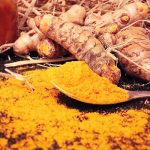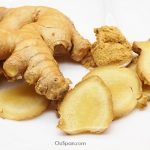
Takeaways
• Cinnamon improves fasting blood glucose in people with type 2 diabetes or prediabetes
• Cinnamon has antimicrobial, antifungal, antioxidative and anti-inflammatory properties
• Cinnamon helps boost metabolism and lose weight
• All cinnamon health benefits are associated with "true" Ceylon cinnamon.
A unique aromatic spice with a warm and slightly sweet taste, cinnamon is the common spice of the most kitchens. Widely used for cooking all over the globe now, this spice has been used for centuries by ancient civilizations and still highly prized in traditional Ayurvedic and Chinese medicine.
The excellent cinnamon health benefits and properties, aroma, and flavor are derived from many organic compounds including Cinnamaldehyde and eugenol that occur naturally in the inner bark of cinnamon trees.
Cinnamon spice is good for flavoring baking goods, oatmeal, breakfast cereals, savoury dishes, tea or coffee and also is great for pickling and preserving. Cinnamon is used as a flavoring of candies and alcoholic beverages. Prepared from inner bark, essential oil is widely used in aromatherapy.
Cinnamon Health Benefits
Cinnamon exhibits a wide range of beneficial properties and also is an excellent source of fibers and minerals such as manganese, iron, and calcium. Cinnamaldehyde, cinnamic acid, cinnamate, and other essential oils constitute unique cinnamon effects and responsible for its aroma and flavor.
The researches are still ongoing, but already completed studies have shown a plethora of cinnamon health benefits including:
- Protection from hyperglycemia by lowering blood sugar
- Control of cholesterol by reducing the level of LDL ("bad" cholesterol)
- Antimicrobial and antifungal properties
- Powerful antioxidant effects
- The immune system boosting
- Anti-inflammatory effects
- Anti-clotting effect on the blood
- Can fight against neurological disorders, such as Parkinson's and Alzheimer's diseases.
Cinnamon for Weight Loss & Metabolism Boosting
If you are organizing all around weight loss plan, you might consider several spices you will use in your low-fat or low-carb diet plan. One spice that exceptionally has to be considered is Cinnamon.
Recent studies have demonstrated that cinnamon reduces lipid and glycogen accumulation in the livers and decrease glucose levels by increasing insulin secretion. Besides, cinnamon regulates carbohydrate metabolism and lipogenesis in the adipose tissue and, also, has anti-hyperglycemic and anti-hyperlipidemic effects.
Published in 2017 in Scientific Reports, a study has suggested that cinnamon possesses a browning effect in subcutaneous (located under the skin) adipose cells. Targeting white adipose tissue, the browning process is a factor of brite cells increasing and thermogenesis activation that, in turn, helps to speed the fat burning process and reduce obesity.
The spice could be added to foods or recipes which are a part of your diet regimen.
Important! Consider using 'True' Ceylon Cinnamon if you plan to incorporate it into your diet daily.
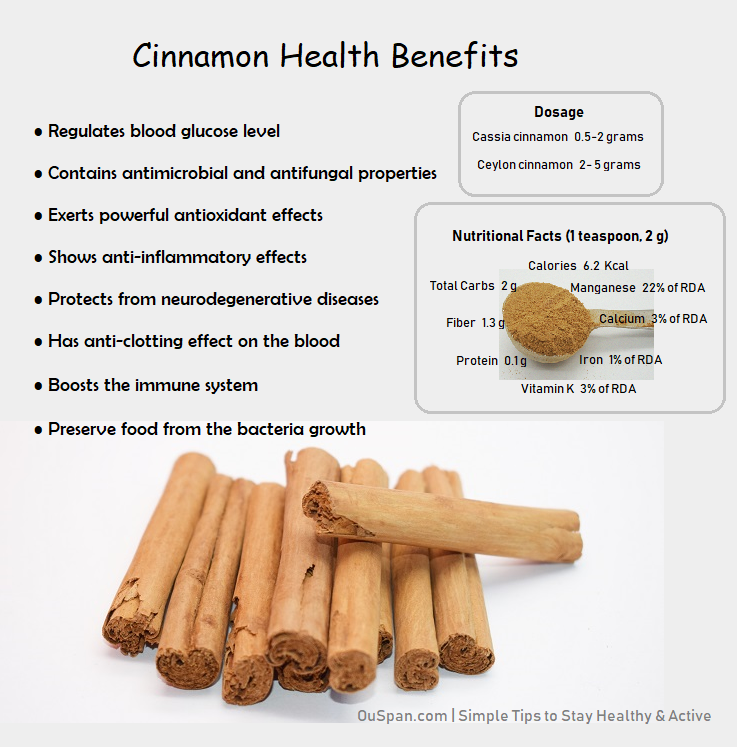
Cinnamon for Diabetics
Insulin sensitivity is one of the key issues of most people with type 2 diabetes or prediabetes. According to the research, published in 2017, the cinnamaldehyde compound in cinnamon lowers blood sugar level by increasing glucose uptake, improving insulin sensitivity in adipose (fat) and muscles cells, and improve glycogen synthesis in the liver. The same research has suggested that cinnamaldehyde can restore pancreatic islets dysfunction, improve diabetic renal and brain disorders.
Polyphenols and chromium presented in cinnamon have beneficial effects on all factors related to metabolic syndrome by improving insulin sensitivity, fasting glucose, controlling cholesterol, blood pressure, and body weight. Consumption of 1-6 g cinnamon a day during 40 days reduces fasting serum glucose by 18-29%, cholesterol level by 12-26%, and "bad" LDL cholesterol by 7-27% in people with type 2 diabetes.
According to the publication in The American Journal of Clinical Nutrition, 6g of cinnamon prevents after-meal glucose spikes and slows the emptying of the stomach without affecting satiety.
More Cinnamon Health Benefits
Found in cinnamon, organic compounds eugenol (polyphenol) and cinnamaldehyde act as antioxidants neutralizing free radicals that can damage cellular structures. Antioxidants lower risk of cardiovascular diseases, infections and some types of cancer.
Cinnamaldehyde also has antibacterial effects on oral and skin infections such as foodborne diseases, Streptococcus, and Staphylococcus.
Cinnamon is well-known for its antifungal properties; it inhibits the growth of fungal infections such as Candida albicans.
Cinnamon alleviates factors associated with Alzheimer's disease by blocking cell swelling that is associated with strokes.
Important! Consider using 'True' Ceylon Cinnamon if you plan to incorporate it into your diet daily.
How to Store Cinnamon
Cinnamon quills and powder should be kept in a cool dark place, tightly sealed to protect against oxygen and moisture. Check Best Before Date on the packaging. Typically, the shelf life of the sticks may be as long as a year and powder may last six months.
Do not use stale ground cinnamon that loses sweet aroma. Grind whole quills in a coffee or spice grinder.
Cinnamon Side Effects & Recommended Dose
There is no established dosage for cinnamon. Some studies suggest 1 to 6 grams a day. But be careful, there might be some side-effects associated with high consumption of Cassia cinnamon.
There are two types of commercially available cinnamon spices: Cassia cinnamon and "True" Ceylon cinnamon.
Commonly available in supermarkets, cheap Cassia cinnamon contains a higher percentage of coumarin which may cause liver damage and toxicity when regularly consuming in a high amount.
According to the study conducted in Germany, Cassia trees growing in China, Indonesia, and Vietnam contain the highest level of coumarin that may vary widely even within a single tree from a small amount to the maximum 10 mg of coumarin in 1 g of the bark.
Czech researchers have checked Cassia cinnamon samples from the retails market and found the coumarin levels of local cinnamon range from 2 650 to 7 017 mg/kg. It means that one teaspoon or 2 grams of Cassia cinnamon contains from 5 to 14 mg of coumarin. An average, a daily safe limit for adults is 5-7 mg. Therefore, if you are not exactly sure about origin your cinnamon, do not consume more then 1/2 to 1 teaspoon a day.
The research has shown that 'True' Ceylon cinnamon is coumarin-free or contains just a trace amount, 18 times less than Cassia sticks and 63 times less than Cassia powder. This type is cinnamon comes from Sri Lanka, Seychelles, and Madagascar.
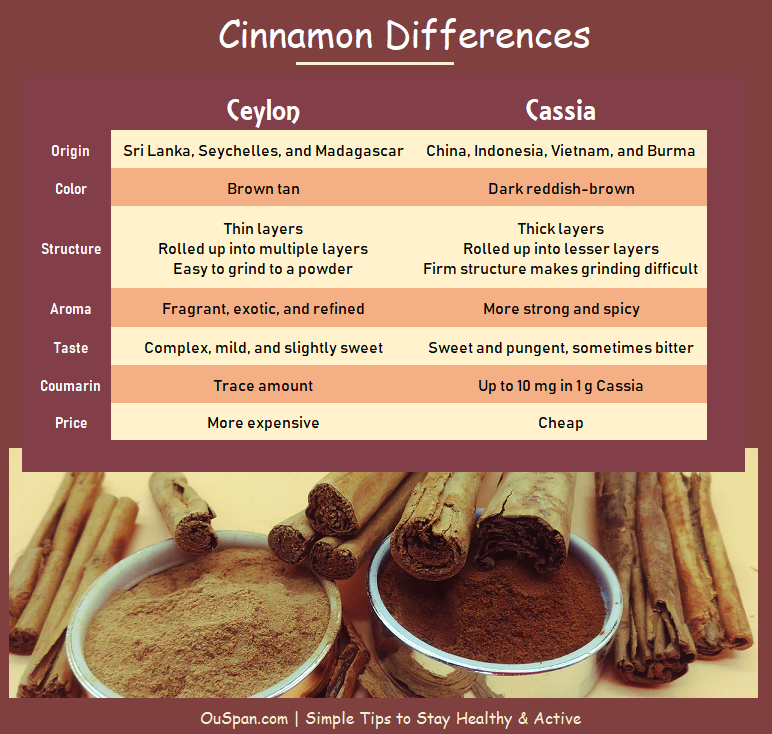
Ways to Distinguish between Two Types of Cinnamon
Cassia cinnamon comes from Cinnamomum cassia trees while 'True' Ceylon cinnamon is derived from Cinnamomum verum species. Both commercially available on the market, these species possess different properties that are key for the right choice.
Most cinnamon sold in grocery stores of the US, Canada, and in many European countries is the Cassia species. Most packages and bottles are labeled as 'Cinnamon' and the place where it was packed. If information about the type of cinnamon and country of origin is not provided, this is most likely Cassia cinnamon. Typically, in the US and Canada, 'True' Ceylon cinnamon is sold in Natural and Organic Stores or you can order it on Amazon, for example, Premium Organic Ceylon Cinnamon. In many countries, 'True' cinnamon is not available in stores.
It is not difficult to distinguish between two types of cinnamon in powder or sticks if you know their features. Prices, taste, aroma, color - all of those are different for both Cassia and Ceylon cinnamons. 'True' Ceylon cinnamon is more expensive.
Color. Ceylon cinnamon is light brown while Cassia is dark reddish brown.
Taste. Ceylon cinnamon has a complex, mild and slightly sweet taste and Cassia has a sweet and spicy, sometimes bitter taste.
Aroma. Most people describe the aroma of Ceylon cinnamon as fragrant, exotic and refined, while Cassia is more intense.
Structure. Ceylon cinnamon quills consist of thinner layers of bark, 1 mm or less, rolled up into multiple layers stick; it is easy to break into small pieces and grind to a powder. Cassia cinnamon quills with thick 2 mm layers are rolled into lesser layers; a firm structure makes grinding difficult.
Related
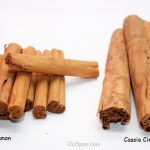 How to Avoid Side Effects of Cinnamon – Ceylon Cinnamon Reviews
How to Avoid Side Effects of Cinnamon – Ceylon Cinnamon Reviews
There are two types of commercially available cinnamon spices: Cassia cinnamon and Ceylon cinnamon...
1. Zhu R, Liu H, Liu C, Wang L, Ma R, Chen B, Li L, Niu J, Fu M, Zhang D, Gao S. Cinnamaldehyde in diabetes: A review of pharmacology, pharmacokinetics, and safety.NCBI.2017
2. Hiu Yee Kwan, Jiahui Wu, Tao Su, Xiao-Juan Chao, Bin Liu, Xiuqiong Fu, Chi Leung Chan, Rebecca Hiu Ying Lau, Anfernee Kai Wing Tse, Quan Bin Han, Wang Fun Fong & Zhi-ling Yu. Cinnamon induces browning in subcutaneous adipocytes. Scientific Reports. 2017.
3. Bolin Qin, M.D., Ph.D., Kiran S. Panickar, and Richard A. Anderson, Ph.D., C.N.S. Cinnamon: Potential Role in the Prevention of Insulin Resistance, Metabolic Syndrome, and Type 2 Diabetes. NCBI. 2010.
4. Hlebowicz J1, Darwiche G, Björgell O, Almér LO. Effect of cinnamon on postprandial blood glucose, gastric emptying, and satiety in healthy subjects. NCBI. 2007
5. American Chemical Society. Levels of coumarin in cassia cinnamon vary greatly even in bark from the same tree. Science Daily.
6. Anderson RA. Chromium and polyphenols from cinnamon improve insulin sensitivity. NCBI. 2008.
7. Jana Blahová and Zdeňka Svobodová. Assessment of Coumarin Levels in Ground Cinnamon Available in the Czech Retail Market. NCBI. 2012
Disclaimer. Statements regarding dietary supplements have not been evaluated by the FDA and are not intended to diagnose, treat, cure, or prevent any disease or health condition.
